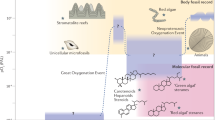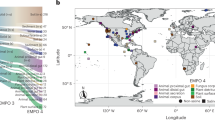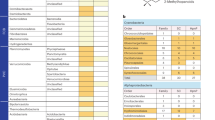Abstract
Our window into the Earth's ancient microbial past is narrow and obscured by missing data. However, we can glean information about ancient microbial ecosystems using fossil lipids (biomarkers) that are extracted from billion-year-old sedimentary rocks. In this Opinion article, we describe how environmental genomics and related methodologies will give molecular fossil research a boost, by increasing our knowledge about how evolutionary innovations in microorganisms have changed the surface of planet Earth.
This is a preview of subscription content, access via your institution
Access options
Subscribe to this journal
Receive 12 print issues and online access
$209.00 per year
only $17.42 per issue
Buy this article
- Purchase on Springer Link
- Instant access to full article PDF
Prices may be subject to local taxes which are calculated during checkout



Similar content being viewed by others
References
Coolen, M. J. L. & Overmann, J. 217,000-year-old DNA sequences of green sulfur bacteria in Mediterranean sapropels and their implications for the reconstruction of the paleoenvironment. Environ. Microbiol. 9, 238–249 (2007).
Werne, J. P. et al. Investigating pathways of diagenetic organic matter sulfurization using compound-specific sulfur isotope analysis. Geochim. Cosmochim. Acta 72, 3489–3502 (2008).
Hebting, Y. et al. Biomarker evidence for a major preservation pathway of sedimentary organic carbon. Science 312, 1627–1631 (2006).
Peters, K. E., Walters, C. C. & Moldowan, J. M. The Biomarker Guide (Cambridge Univ. Press, UK, 2004).
Kuypers, M. M. M. et al. Massive expansion of marine archaea during a mid-Cretaceous oceanic anoxic event. Science 293, 92–94 (2001).
Schouten, S., Hopmans, E. C., Schefuss, E. & Sinninghe Damsté, J. S. Distributional variations in marine crenarchaeotal membrane lipids: a new tool for reconstructing ancient sea water temperatures? Earth Planet. Sci. Lett. 204, 265–274 (2002).
Sluijs, A. et al. Environmental precursors to rapid light carbon injection at the Palaeocene/Eocene boundary. Nature 450, 1218–1221 (2007).
Summons, R. E., Powell, T. G. & Boreham, C. J. Petroleum geology and geochemistry of the Middle Proterozoic McArthur Basin, northern Australia: III. Composition of extractable hydrocarbons. Geochim. Cosmochim. Acta 52, 1747–1763 (1988).
Brocks, J. J. et al. Biomarker evidence for green and purple sulphur bacteria in a stratified Paleoproterozoic sea. Nature 437, 866–870 (2005).
Giovannoni, S. & Stingl, U. The importance of culturing bacterioplankton in the 'omics' age. Nature Rev. Microbiol. 5, 820–826 (2007).
Achtman, M. & Wagner, M. Microbial diversity and the genetic nature of microbial species. Nature Rev. Microbiol. 6, 431–440 (2008).
Brocks, J. J. & Summons, R. E. in Treatise on Geochemistry Vol. 8 (ed. Schlesinger, W. H.) 63–115 (Elsevier–Pergamon, Oxford, 2004).
Medini, D. et al. Microbiology in the post-genomic era. Nature. Rev. Microbiol. 6, 419–430 (2008).
Amann, R. & Fuchs, B. M. Single-cell identification in microbial communities by improved fluorescence in situ hybridization techniques. Nature Rev. Microbiol. 6, 339–348 (2008).
Pearson, A., Flood Page, S. R., Jorgenson, T. L., Fischer, W. W. & Higgins, M. B. Novel hopanoid cyclases from the environment. Environ. Microbiol. 9, 2175–2188 (2007).
Ourisson, G. in Early Life on Earth, Nobel Symposium Vol. 84 (ed. Bengtson, S.) 259–269 (Columbia Univ. Press, New York, 1994).
Summons, R. E., Jahnke, L. L., Hope, J. M. & Logan, G. A. 2-Methylhopanoids as biomarkers for cyanobacterial oxygenic photosynthesis. Nature 400, 554–557 (1999).
Wilmes, P., Simmons, S. L., Denef, V. J. & Banfield, J. F. The dynamic genetic repertoire of microbial communities. FEMS Microbiol. Rev. 33, 109–132 (2009).
Tyson, G. W. et al. Community structure and metabolism through reconstruction of microbial genomes from the environment. Nature 428, 37–43 (2004).
Hart, E. A. et al. Directed evolution to investigate steric control of enzymatic oxidosqualene cyclization. An isoleucine-to-valine mutation in cycloartenol synthase allows lanosterol and parkeol biosynthesis. J. Am. Chem. Soc. 121, 9887–9888 (1999).
Ohnuma, S. et al. A pathway where polyprenyl diphosphate elongates in prenyltransferase. Insight into a common mechanism of chain length determination of prenyltransferases. J. Biol. Chem. 273, 26705–26713 (1998).
Sinninghe Damsté, J. S. et al. Linearly concatenated cyclobutane lipids form a dense bacterial membrane. Nature 419, 708–712 (2002).
Sessions, A. L., Sylva, S. P. & Hayes, J. M. A moving-wire device for carbon-isotopic analyses of nanogram quantities of nonvolatile organic carbon. Anal. Chem. 77, 6519–6527 (2005).
Orphan, V. J., House, C. H., Hinrichs, K. U., McKeegan, K. D. & DeLong, E. F. Methane-consuming archaea revealed by directly coupled isotopic and phylogenetic analysis. Science 293, 484–487 (2001).
Thiel, V. et al. Biomarkers at the microscopic range: ToF-SIMS molecular imaging of Archaea-derived lipids in a microbial mat. Geobiology 5, 413–421 (2007).
Shin, D. et al. Structure-based inference of molecular functions of proteins of unknown function from Berkeley Structural Genomics Center. J. Struct. Funct. Genomics 8, 99–105 (2007).
Allen, H. K., Moe, L. A., Rodbumrer, J., Gaarder, A. & Handelsman, J. Functional metagenomics reveals diverse b-lactamases in a remote Alaskan soil. ISME J. 3, 241–251 (2008).
Lim, H. K. et al. Characterization of a forest soil metagenome clone that confers indirubin and indigo production on Escherichia coli. Appl. Environ. Microbiol. 71, 7768–7777 (2005).
Meng, J. et al. An uncultivated crenarchaeota contains functional bacteriochlorophyll a synthase. ISME J. 3, 106–116 (2009).
Tyson, G. W. & Banfield, J. F. Cultivating the uncultivated: a community genomics perspective. Trends Microbiol. 13, 411–415 (2005).
Denef, V. J., Shah, M. B., VerBerkmoes, N. C., Hettich, R. L. & Banfield, J. F. Implications of strain- and species-level sequence divergence for community and isolate shotgun proteomic analysis. J. Proteome Res. 6, 3152–3161 (2007).
Ram, R. J. et al. Community proteomics of a natural microbial biofilm. Science 308, 1915–1920 (2005).
Lo, I. et al. Strain-resolved community proteomics reveals recombining genomes of acidophilic bacteria. Nature 446, 537–541 (2007).
Walker, A. & Parkhill, J. Single-cell genomics. Nature Rev. Microbiol. 6, 176–177 (2008).
Raes, J. & Bork, P. Molecular eco-systems biology: towards an understanding of community function. Nature Rev. Microbiol. 6, 693–699 (2008).
Woyke, T. et al. Assembling the marine metagenome, one cell at a time. PLoS ONE 4, e5299 (2009).
VerBerkmoes, N. C., Denef, V. J., Hettich, R. L. & Banfield, J. F. Functional analysis of natural microbial consortia using community proteomics. Nature Rev. Microbiol. 7, 196–205 (2009).
Frias-Lopez, J. et al. Microbial community gene expression in ocean surface waters. Proc. Natl Acad. Sci. USA 105, 3805–3810 (2008).
Pearson, A., Budin, M. & Brocks, J. J. Phylogenetic and biochemical evidence for sterol synthesis in the bacterium Gemmata obscuriglobus. Proc. Natl Acad. Sci. USA 100, 15352–15357 (2003).
Roberts, M. S. & Cohan, F. M. The effect of DNA sequence divergence on sexual isolation in Bacillus. Genetics 134, 401–408 (1993).
Eppley, J. M., Tyson, G. W., Getz, W. M. & Banfield, J. F. Genetic exchange across a species boundary in the archaeal genus Ferroplasma. Genetics 177, 407–416 (2007).
Canfield, D. E. The early history of atmospheric oxygen: homage to Robert M. Garrels. Annu. Rev. Earth Planet Sci. 33, 1–36 (2005).
Canfield, D. E., Poulton, S. W. & Narbonne, G. M. Late-Neoproterozoic deep-ocean oxygenation and the rise of animal life. Science 315, 92–95 (2007).
Hoffman, P. F., Kaufman, A. J., Halverson, G. P. & Schrag, D. P. A Neoproterozoic snowball Earth. Science 281, 1342–1346 (1998).
Kirschvink, J. L. & Kopp, R. E. Palaeoproterozoic ice houses and the evolution of oxygen-mediating enzymes: the case for a late origin of photosystem II. Philos. Trans. R. Soc. Lond. B 363, 2755–2765 (2008).
Bekker, A. et al. Dating the rise of atmospheric oxygen. Nature 427, 117–120 (2004).
Anbar, A. D. et al. A whiff of oxygen before the Great Oxidation Event? Science 317, 1903–1906 (2007).
Kaufman, A. J. et al. Late Archean biospheric oxygenation and atmospheric evolution. Science 317, 1900–1903 (2007).
Wille, M. et al. Evidence for a gradual rise of oxygen between 2.6 and 2.5 Ga from Mo isotopes and Re-PGE signatures in shales. Geochim. Cosmochim. Acta 71, 2417–2435 (2007).
Sinninghe Damsté, J. S. et al. The rise of the rhizosolenid diatoms. Science 304, 584–587 (2004).
Xiao, S., Zhang, Y. & Knoll, A. H. Three-dimensional preservation of algae and animal embryos in a Neoproterozoic phosphorite. Nature 391, 553–558 (1998).
Love, G. D. et al. Fossil steroids record the appearance of Demospongiae during the Cryogenian period. Nature 457, 718–721 (2009).
Knoll, A. H., Javaux, E., Hewitt, D. & Cohen, P. Eukaryotic organisms in Proterozoic oceans. Philos. Trans. R. Soc. Lond. B 361, 1023–1038 (2006).
Butterfield, N. J. A vaucheriacean alga from the middle Neoproterozoic of Spitsbergen: implications for the evolution of Proterozoic eukaryotes and the Cambrian explosion. Paleobiology 30, 231–252 (2004).
Rasmussen, B., Bengtson, S., Fletcher, I. R. & McNaughton, N. J. Discoidal impressions and trace-like fossils more than 1200 million years old. Science 296, 1112–1115 (2002).
Hofmann, H. J. Precambrian microflora, Belcher Islands, Canada: significance and systematics. J. Paleontol. 50, 1040–1073 (1976).
Rasmussen, B., Fletcher, I. R., Brocks, J. J. & Kilburn, M. R. Reassessing the first appearance of eukaryotes and Cyanobacteria. Nature 455, 1101–1104 (2008).
Brocks, J. J., Summons, R. E., Buick, R. & Logan, G. A. Origin and significance of aromatic hydrocarbons in giant iron ore deposits of the late Archean Hamersley Basin in Western Australia. Org. Geochem. 34, 1161–1175 (2003).
Kazmierczak, J. & Altermann, W. Neoarchean biomineralization by benthic cyanobacteria. Science 298, 2351 (2002).
Shen, Y., Buick, R. & Canfield, D. E. Isotopic evidence for microbial sulphate reduction in the early Archaean era. Nature 410, 77–81 (2001).
Hayes, J. M. in Early Life on Earth (ed. Bengtson, S.) 220–236 (Columbia Univ. Press, New York, 1994).
Hinrichs, K.-U. Microbial fixation of methane carbon at 2.7 Ga: was an anaerobic mechanism possible? Geochem. Geophys. Geosyst. 3, 1042 (2002).
Rasmussen, B. Filamentous microfossils in a 3,235-million-year-old volcanogenic massive sulphide deposit. Nature 405, 2676–2679 (2000).
Philippot, P. et al. Early Archaean microorganisms preferred elemental sulfur, not sulfate. Science 317, 1534–1537 (2007).
Ueno, Y., Yamada, K., Yoshida, N., Maruyama, S. & Isozaki, Y. Evidence from fluid inclusions for microbial methanogenesis in the early Archaean era. Nature 440, 516–519 (2006).
Walter, M. R., Buick, R. & Dunlop, J. S. R. Stromatolites 3,400–3,500 Myr old from the North Pole area, Western Australia. Nature 284, 443–445 (1980).
Rosing, M. T. 13C-depleted carbon microparticles in >3700-Ma sea-floor sedimentary rocks from West Greenland. Science 283, 674–676 (1999).
Teeling, H., Meyerdierks, A., Bauer, M., Amann, R. & Glöckner, F. O. Application of tetranucleotide frequencies for the assignment of genomic fragments. Environ. Microbiol. 6, 938–947 (2004).
Abe, T., Sugawara, H., Kinouchi, M., Kanaya, S. & Ikemura, T. Novel phylogenetic studies of genomic sequence fragments derived from uncultured microbe mixtures in environmental and clinical samples. DNA Res. 12, 281–290 (2005).
Mavromatis, K. et al. Use of simulated data sets to evaluate the fidelity of metagenomic processing methods. Nature Methods 4, 495–500 (2007).
Karlin, S., Mrázek, J. & Campbell, A. M. Compositional biases of bacterial genomes and evolutionary implications. J. Bacteriol. 179, 3899–3913 (1997).
Vink, A., Schouten, S., Sephton, S. & Sinninghe Damsté, J. S. A newly discovered norisoprenoid, 2,6,15,19-tetramethylicosane, in Cretaceous black shales. Geochim. Cosmochim. Acta 62, 965–970 (1998).
Thiel, V. et al. Highly isotopically depleted isoprenoids: molecular markers for ancient methane venting. Geochim. Cosmochim. Acta 63, 3959–3966 (1999).
Schouten, S., van der Maarel, M. J., Huber, R. & Sinninghe Damsté, J. S. 2,6,10,15,19-pentamethylicosenes in Methanolobus bombayensis, a marine methanogenic archaeon, and in Methanosarcina mazei. Org. Geochem. 26, 409–414 (1997).
Rohmer, M., Bouvier-Navé, P. & Ourisson, G. Distribution of hopanoid triterpenes in prokaryotes. J. Gen. Microbiol. 130, 1137–1150 (1984).
Rashby, S. E., Sessions, A. L., Summons, R. E. & Newman, D. K. Biosynthesis of 2-methylbacteriohopanepolyols by an anoxygenic phototroph. Proc. Natl Acad. Sci. USA 104, 15099–15104 (2007).
Zundel, M. & Rohmer, M. Prokaryotic triterpenoids 1. 3 b-methylhopanoids from Acetobacter species and Methylococcus capsulatus. Eur. J. Biochem. 150, 23–27 (1985).
Summons, R. E. & Jahnke, L. L. in Biological Markers in Sediments and Petroleum (eds Moldowan, J. M., Albrecht, P. & Philp, R. P.) 182–200 (Prentice Hall, New Jersey, 1992).
Bird, C. W. et al. Steroids and squalene in Methylococcus capsulatus grown on methane. Nature 230, 473–474 (1971).
Schaeffer, P., Adam, P., Wehrung, P. & Albrecht, P. Novel aromatic carotenoid derivatives from sulfur photosynthetic bacteria in sediments. Tetrahedr. Lett. 38, 8413–8416 (1997).
Summons, R. E. & Powell, T. G. Chlorobiaceae in Paleozoic seas revealed by biological markers, isotopes and geology. Nature 319, 763–765 (1986).
Brocks, J. J. & Schaeffer, P. Okenane, a biomarker for purple sulfur bacteria (Chromatiaceae), and other new carotenoid derivatives from the 1,640 Ma Barney Creek Formation. Geochim. Cosmochim. Acta 72, 1396–1414 (2008).
Holba, A. G. et al. 24-norcholestanes as age-sensitive molecular fossils. Geology 26, 783–786 (1998).
Volkman, J. K. Sterols in microorganisms. Appl. Microbiol. Biotechnol. 60, 496–506 (2003).
Bode, H. B. et al. Steroid biosynthesis in prokaryotes: identification of myxobacterial steroids and cloning of the first bacterial 2,3(S)-oxidosqualene cyclase from the myxobacterium Stigmatella aurantiaca. Mol. Microbiol. 47, 471–481 (2003).
Grantham, P. J. & Wakefield, L. L. Variations in the sterane carbon number distribution of marine source rock derived oils through geological time. Org. Geochem. 12, 61–73 (1988).
Moldowan, J. M. et al. Sedimentary 24-n-propylcholestanes, molecular fossils diagnostic of marine algae. Science 247, 309–312 (1990).
McCaffrey, M. A. et al. Paleoenvironmental implications of novel C30 steranes in Precambrian to Cenozoic age petroleum and bitumen. Geochim. Cosmochim. Acta 58, 529–532 (1994).
McCaffrey, A. M., Dahl, J. E. P., Sundararaman, P., Moldowan, J. M. & Schoell, M. Source rock quality determination from oil biomarkers II: a case study using tertiary-reservoired Beauford Sea oils. Am. Assoc. Pet. Geol. Bull. 78, 1527–1540 (1994).
Moldowan, J. M. & Talyzina, N. M. Biogeochemical evidence for dinoflagellate ancestors in the Early Cambrian. Science 281, 1168–1170 (1998).
Nichols, P. D., Volkman, J. K., Palmisano, A. C., Smith, G. A. & White, D. C. Occurrence of an isoprenoid C25 di-unsaturated alkene and high neutral lipid content in Antarctic sea-ice diatom communities. J. Phycol. 24, 90–96 (1988).
Brassell, S. C., Eglinton, G., Marlowe, I. T., Pflaumann, U. & Sarnthein, M. Molecular stratigraphy: a new tool for climatic assessment. Nature 320, 129–133 (1986).
Ten Haven, H. L., Rohmer, M., Rullkötter, J. & Bisseret, P. Tetrahymanol, the most likely precursor of gammacerane, occurs ubiquitously in marine sediments. Geochim. Cosmochim. Acta 53, 3073–3079 (1989).
Sinninghe Damsté, J. S. et al. Evidence for gammacerane as an indicator of water column stratification. Geochim. Cosmochim. Acta 59, 1895–1900 (1995).
van Aarssen, B. G. K., Hessels, J. K. C., Abbink, O. A. & de Leeuw, J. W. The occurrence of polycyclic sesqui-, tri-, and oligoterpenoids derived from a resinous polymeric cadinene in crude oils from southeast Asia. Geochim. Cosmochim. Acta 56, 1231–1246 (1992).
Moldowan, J. M. et al. The molecular fossil record of oleanane and its relation to angiosperms. Science 265, 768–771 (1994).
Noble, R. A., Alexander, R., Kagi, R. I. & Knox, J. Tetracyclic diterpenoid hydrocarbons in some Australian coals, sediments and crude oils. Geochim. Cosmochim. Acta 49, 2141–2147 (1985).
Acknowledgements
We thank W. Fischer and B. Rasmussen for advice on figure 1.
Author information
Authors and Affiliations
Corresponding author
Related links
Rights and permissions
About this article
Cite this article
Brocks, J., Banfield, J. Unravelling ancient microbial history with community proteogenomics and lipid geochemistry. Nat Rev Microbiol 7, 601–609 (2009). https://doi.org/10.1038/nrmicro2167
Issue Date:
DOI: https://doi.org/10.1038/nrmicro2167
This article is cited by
-
Spatial Variability of Microbial Communities and Salt Distributions Across a Latitudinal Aridity Gradient in the Atacama Desert
Microbial Ecology (2021)
-
Hydrocarbon generation characteristics and exploration prospects of Proterozoic source rocks in China
Science China Earth Sciences (2019)
-
Bacterial diversification through geological time
Nature Ecology & Evolution (2018)
-
Schrödinger’s microbes: Tools for distinguishing the living from the dead in microbial ecosystems
Microbiome (2017)
-
Experimental diagenesis of organo-mineral structures formed by microaerophilic Fe(II)-oxidizing bacteria
Nature Communications (2015)



